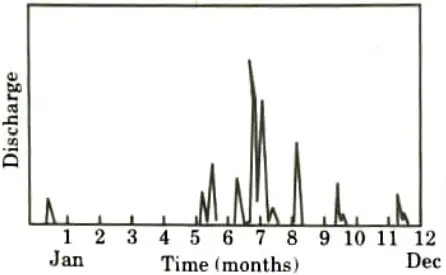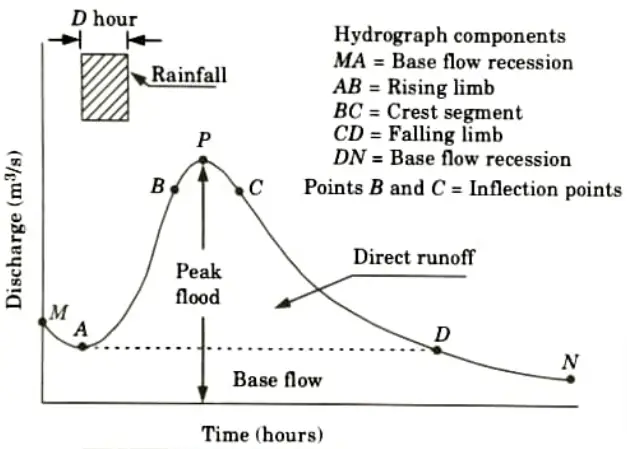Aktu Btech Quantum Notes can help you improve your Engineering Hydrology preparation. To excel in your tests, access critical, recurrent questions and extensive content. Improve your understanding right now! Unit-2 Runoff and Hydrographs
Dudes 🤔.. You want more useful details regarding this subject. Please keep in mind this as well. Important Questions For Engineering Hydrology: *Quantum *B.tech-Syllabus *Circulars *B.tech AKTU RESULT * Btech 3rd Year * Aktu Solved Question Paper
Q1. Define runoff and discuss the types of runoff.
Ans. Runoff:
- 1. The draining or flowing off of precipitation from a catchment area through a surface channel is referred to as runoff.
- 2. It represents the catchment’s output in a particular unit of time.
Types of Runoff: Based on the time delay between the precipitation and the runoff, the runoff is classified into two categories as:
- 1. Direct Runoff:
- i. It is the portion of runoff that enters the stream shortly after rainfall.
- ii. It includes surface runoff, rapid interflow, and rainfall on the stream’s surface.
- iii. When snow melts, the resulting flow into the stream is also a direct runoff.
- iv. Direct runoff is sometimes referred to as direct storm runoff or storm runoff.
- 2. Base Flow:
- i. Base flow is the delayed flow that reaches a stream essentially as groundwater flow.
- ii. Delayed interflow is frequently included in this category.
- iii In an annual hydrograph of a perennial stream, the base flow is clearly identified as the stream’s progressively declining flow during rainless seasons.
Q2. With the help of typical hydrographs describe the salient features of:
i. Perennial.
ii. Intermittent.
iii. Ephemeral streams.
Ans. A study of the annual hydrographs of streams enables one to classify streams into three classes as:
1. Perennial Stream:
- i. A perennial stream is one which always carries some flow in it Fig.
- ii. There is considerable amount of groundwater flow throughout the year.
- iii. Even during the dry seasons the water table will be above the bed of the stream.



2. Intermittent Stream:
- i. An intermittent stream receives just a little amount of groundwater.
- ii. During the wet season, the water table rises above the stream bed, and the base flow contributes to the stream flow.
- iii. During dry seasons, however, the water table descends to a level lower than the stream bed, causing the stream to dry up.
- iv. With the exception of the rare storm, which can provide a brief flow, the stream remains dry for the majority of the dry months (Fig.)



3. Ephemeral Stream:
- i. An ephemeral stream is one that has no base flow contribution.
- ii. The annual hydrograph of such a river exhibits a series of short-duration spikes indicating storm-related flash floods (Fig.).
- iii. The stream turns dry quickly after the storm flow has ended. An ephemeral stream typically lacks a well-defined channel.
- iv. The majority of rivers in arid areas are ephemeral.



Q3. What is hydrograph ? Draw a single peaked hydrograph and explain its components.
Ans. A. Hydrograph: A plot of the discharge in a stream plotted against time chronologically is called a hydrograph.
B. Components of Hydrograph: The essential components of a hydrograph are described below:
1. Rising Limb:
- i. The rising limb of a hydrograph, also known as the concentration curve, depicts the progressive rise in discharge caused by storage accumulation in channels and on the catchment surface.
- ii. The initial losses and significant infiltration losses during the early stages of a storm lead the discharge to rise slowly.
- iii. As the storm progresses, more and more flow from distant regions of the basin reaches the basin outflow.
- iv. Concurrently, infiltration losses reduce with time. As a result, during a uniform storm over the catchment, runoff increases fast over time.
- v. As previously stated, the basin and storm characteristics influence the shape of a hydrograph’s rising limb.
2. Crest Segment:
- i. The crest segment is one of the most essential components of a hydrograph since it contains the peak flow.
- ii. The peak flow occurs when runoff from multiple sections of the watershed combine. Contribute amounts in parallel to produce the greatest quantity of flow at the basin outlet.
- iii. In general, for large catchments, peak flow occurs after the rainfall has stopped, with the time interval between the centre of mass of rainfall and the peak being mostly influenced by basin and storm features.



3. Recession Limb:
- i. The recession limb, which spans from the point of inflection at the end of the crest segment (point C in Fig.) to the start of natural groundwater flow (point D in Fig.), depicts the withdrawal of water from the basin’s store built up during the earlier phases of the hydrograph.
- ii. The starting point of the recession limb, i.e. the point of inflection, denotes the maximum storage state.
- iii. Because storage depletion occurs after rainfall has stopped, the shape of this component of the hydrograph is independent of storm characteristics and wholly dependent on basin parameters.
- iv. The storage of water in the basin exists as (i) surface storage, which includes both surface detention and channel storage, (ii) interflow storage, and (iii) groundwater storage, i.e., base-flow storage.
Q4. Discuss the several assumptions underlying the UH method in hydrological analysis.
Ans. A. Unit Hydrograph:
- 1. A unit hydrograph (or unit-graph) is the direct runoff hydrograph produced by one centimetre (or millimetre or inch) of excess rainfall created uniformly over a catchment area at a steady rate for an effective duration.
- 2. A catchment basin’s unit hydrograph is the direct runoff hydrograph produced by a unit (typically 1 cm) rainfall surplus from a storm of D-hour length, and so represents the basin’s lumped response to the storm.
B. Assumptions: Following are the basic assumptions in the unit hydrograph theory:
- 1. Within the effective storm period of D-hours, the extra rainfall has a constant intensity (1/D cm/hr).
- 2. Excess rainfall (resulting in a 1 cm depth of runoff) is spread uniformly throughout the catchment basin.
- 3. The direct runoff hydrograph’s base time (i.e., the duration of the direct runoff caused by an excess rainfall of a particular duration) is constant.
- 4. All direct runoff hydrographs of a common base time have ordinates that are directly proportionate to the entire amount of direct runoff indicated by each hydrograph.
- 5. For a given catchment basin, the hydrograph produced by a certain surplus rainfall represents the catchment basin’s constant properties.
Q5. Unit hydrograph ordinates of 4 hour are given below. Find out ordinates of 8 hr.



Ans. Given: The ordinates of 4-h unit hydrograph
To Find: The ordinates of 8-h unit hydrograph
- 1. When 2 unit hydrographs, each of 4-hr duration, are added together placed at 4-hr lag successively from one another, then we will get the ordinates of 8-hr.
- 2. Surface runoff hydrograph, containing 2 cm of direct runoff. Hence the ordinates of a 8-hr unit hydrograph are obtained by dividing each of the ordinates of 8-hr hydrograph by 2.
- 3.The computations are done in table.



Q6. What do you mean by design flood? What are the factors affecting the flood hydrograph ?
Ans. A. Design Flood: It is the instantaneous peak discharge value used in the design of a specific project or any of its structures. The phrase design flood refers to the maximum flood flow that could pass through an engineering structure without causing damage or posing a major threat to its stability.
B. Factors: Following are the factors affecting the flood hydrograph:
- 1. Physiographic Factors:
- i. Basin characteristics:
- a Shape.
- b. Size.
- c. Slope.
- d. Nature of the valley.
- e. Elevation.
- f. Drainage density.
- ii. Infiltration characteristics:
- a. Land use and cover.
- b. Soil type and geological conditions.
- c. Lakes, swamps and other storage.
- iii. Channel characteristics: Cross-section, roughness, and storage capacity.
- i. Basin characteristics:
- 2. Climatic Factors:
- i. Storm characteristics: Precipitation, intensity, duration, magnitude, and movement of storm.
- ii. Initial loss.
- iii. Evapotranspiration.
- 3 Shape of the Basin:
- i. The form of the basin determines the time it takes for water to reach at the exit from remote sections of the catchment. As a result, the basin form influences the occurrence of the peak and thus the shape of the hydrograph.
- ii. Fan-shaped catchments, i.e., roughly semicircular catchments, produce high peak and narrow hydrographs, whereas elongated catchments produce broad and low-peaked hydrographs.
- 4 Size:
- i. Little basins differ from large basins in terms of the relative relevance of different phases of the runoff phenomena.
- ii. In small catchments, overland flow predominates over channel flow.
- iii. As a result, land use and rainfall intensity play a major effect in peak flood. These impacts are decreased in big basins because the channel flow phase is more prevalent.
- 5. Slope:
- i. The velocity of flow through the channel is controlled by the slope of the main stream.
- ii. Because the recession limb of the hydrograph depicts storage depletion, the stream channel slope will have a significant impact on this region of the hydrograph.
- iii. Large stream slopes cause faster depletion of storage, resulting in steeper recession limbs of hydrographs.
- iv. The basin slope is significant in small catchments where overland flow is substantially greater. In such circumstances, the catchment’s greater slope results in higher peak outflows.
- 6. Drainage Density:
- i. The drainage density is calculated by dividing the total channel length by the total drainage area.
- ii. A high drainage density produces a favorable environment for the rapid disposal of runoff along the channels.
- iii. This rapid response is represented in a prominent peaked discharge.
- iv. In basins with lower drainage densities, overland flow dominates, resulting in a squat hydrograph with a gently ascending limb.
- 7. Climatic Factors:
- i. The strength, length, and direction of storm movement are the three most critical meteorological parameters influencing the shape of a flood hydrograph.
- ii. The peak and volume of surface runoff are essentially proportional to the intensity of rainfall over a certain time period.
This feature is used in the unit hydrograph theory for calculating peak-flow hydrographs.



Important Question with solutions | AKTU Quantums | Syllabus | Short Questions
Engineering Hydrology Btech Quantum PDF, Syllabus, Important Questions
| Label | Link |
|---|---|
| Subject Syllabus | Syllabus |
| Short Questions | Short-question |
| Question paper – 2021-22 | 2021-22 |
Engineering Hydrology Quantum PDF | AKTU Quantum PDF:
| Quantum Series | Links |
| Quantum -2022-23 | 2022-23 |
AKTU Important Links | Btech Syllabus
| Link Name | Links |
|---|---|
| Btech AKTU Circulars | Links |
| Btech AKTU Syllabus | Links |
| Btech AKTU Student Dashboard | Student Dashboard |
| AKTU RESULT (One View) | Student Result |
